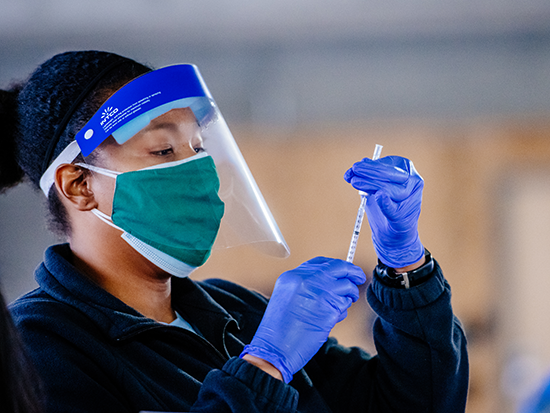 Workers in America’s emergency departments were more likely to contract COVID-19 in the early days of the pandemic in community settings or at home rather than when providing patient care in a hospital setting, according to new research conducted at emergency departments across the nation.
Workers in America’s emergency departments were more likely to contract COVID-19 in the early days of the pandemic in community settings or at home rather than when providing patient care in a hospital setting, according to new research conducted at emergency departments across the nation.
The study, part of the COVID-19 Evaluation of Risks in Emergency Departments, known as the Project COVERED study, found that personal protective equipment, including masks, gloves and protective gowns, helped keep emergency health care workers shielded from infection while caring for patients. The study was published July 22 in the journal PLOS ONE.
“From the start of the pandemic, emergency department personnel served as the initial hospital caregivers for the majority of critically ill patients with known or suspected COVID-19 infection,” said Walter Schrading, M.D., professor in the Department of Emergency Medicine in the Heersink School of Medicine at the University of Alabama at Birmingham. Schrading is a co-author on the study.
Between May and December 2020, prior to the COVID-19 vaccine availability, emergency department staff at 20 medical centers across the country were followed with surveys, COVID-19 tests and serology testing. The study included 1,673 emergency department physicians, advanced practice providers, nurses and non-clinical staff who were observed over 20 weeks and 30,000 person-weeks in total. During this surveillance, more than 4,400 high-risk aerosolizing intubations were performed.
“At the beginning of the pandemic, the risk of providing emergency patient care was not understood. Emergency care staff were committed to their role in responding to the crisis, but they were understandably anxious,” said Nicholas Mohr, M.D., lead author and co-principal investigator of the study, at the University of Iowa Hospitals and Clinics. “Even though emergency care workers felt vulnerable performing procedures and providing clinical care for COVID-19 patients during this time, our findings support that it was really when they were outside the hospital and at home, with their families and friends, and in their community that people were at risk of infection.”
 The study found that only 4.5 percent of emergency personnel became infected with COVID-19, and the most prominent factors associated with those infections were community exposures, hospital case counts and mask use in public.
The study found that only 4.5 percent of emergency personnel became infected with COVID-19, and the most prominent factors associated with those infections were community exposures, hospital case counts and mask use in public.
“This study does provide reassurance to health care professionals that, with the proper precautions, they can be relatively safe while treating patients in the emergency medicine setting,” Schrading said. “PPE is effective at preventing COVID-19 transmission during clinical care, so when case counts are high in the community, health care personnel should take precautions outside the hospital just as they do inside the hospital when they are working.”
This project was funded by a cooperative agreement from the Centers for Disease Control and Prevention (U01CK000480) and the Institute for Clinical and Translational Science at the University of Iowa through a grant from the National Center for Advancing Translational Sciences at the National Institutes of Health (UL1TR002537).
Additional researchers on this study are David Talan, Anusha Krishnadasan and William Mower of the University of California, Los Angeles; Karisa Harland and Patrick Ten Eyck of the University of Iowa; Juan Carlos Montoy of the University of California, San Francisco; Preeta K. Kutty, Elisabeth Hesse and Scott Santibanez of the CDC; David Weissman of the National Institute for Occupational Safety and Health/CDC; and Patricia Slev of ARUP Laboratories.